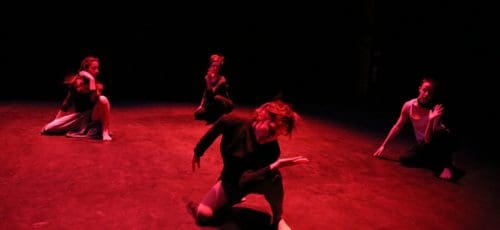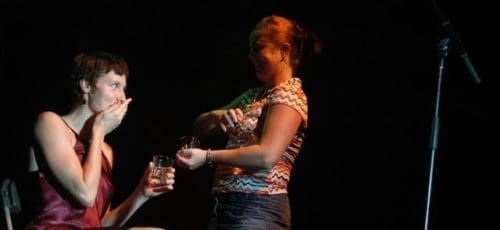Catching up with fidget and Megan Bridge
In June 2009, Megan Bridge and her co-collaborator, the composer, designer, and musicologist Peter Price opened thefidget space, a warehouse, research laboratory, and hub for new forms of art, media, and performance in Kensington, Philadelphia. Since 2009, <fidget> has curated and produced 55 different programs ranging from free lectures to experimental dance, music, and theater performances. It is also a platform for Megan’s collaborative work with Price.
For those who have been to the performance space/loft/studio/home, seeing a show at thefidget space is a true underground-scene experience, and each time I go there I feel like I’m being let in on a secret society of dance artists. And a welcoming one, because there’s usually a loft-lounge vibe and beer. FringeArts recently sat down with Megan Bridge to catch on up on the latest at the space and her work as a dancer, choreographer, curator, and dance writer.
FringeArts: How has <fidget> evolved since its opening?
Megan Bridge: When we first started hosting performances and other events in 2009, it was completely accidental. Some people caught wind that we had a big space and they asked if they could do their Fringe shows here. We were open to the idea, but the floors were really terrible for dance. So, they helped us install a floor! We said yes to almost everything when people started approaching us in the beginning. The main thing that has evolved is our curatorial vision. We didn’t really have a vision and just wanted to support as many projects as possible. Since 2009, we’ve cultivated a curatorial platform that revolves around experimentalism and shaping the discourse around what we’re making.
FringeArts: What are some things you would pass on to those thinking about opening their own space?
Megan Bridge: Over the last four years we’ve had to learn how to say no to people. It isn’t easy! Especially when we are saying no to friends and close colleagues. But this is one of the most important things we’ve learned. We’re still learning. It has protected us from burn out, although we are still doing way too much. It’s helped to create an identity for <fidget>.
FringeArts: What projects are happening at <fidget> with outside artists?
Megan Bridge: In our 2012-2013 season, we presented a ton of work by outside artists and a lot of work got made here. A major highlight of the season was our Deborah Hay Festival co-produced with Mascher Space Co-op last November. Another was the “Art of Noise” Cocktail Party we hosted in March, celebrating the centennial year of Luigi Russolo’s Art of Noise Manifesto with Alex Waterman, Aliza Shvarts, and other guest lecturers and performers. Our most recent events by outside artists were SHARE, an improv-jam session with a guest set by a great chamber ensemble called thingNY and our season closer, Katie McNamara’s Strung. With Mascher, we presented three mixed bills of choreography by twelve different local and New York artists and each of those shows also traveled to Center for Performance Research in Brooklyn.
Susan Rethorst was in residence in January working on her piece 208 East Broadway and we also hosted a wrecking of this work [when other artists take over as choreographer and do what they will with the dance] with Annie B. Parson and Paul Lazar of Big Dance Theater. In April, she wrecked two of <fidget>’s pieces situation: becoming and dust. Also in Spring, we had various dance and theater companies workshopping and creating new projects including Team Sunshine’s JapanAmerica Wonderwave, Applied Mechanics’s Vainglorious, and Here[begin] Dance’s shatter:::dawn. We presented fifteen different programs by outside artists that were open to the public between September 2012 and June 2013. That’s not including 27 different performances and events that we were directly involved with either as <fidget> or as independent artists.
FringeArts: What are you working on within <fidget>?
Megan Bridge: We have two big research projects in the hopper. The first is something we were researching in our Process Project series, an improvisational research platform in which we open our home studio to a small invited audience and perform thirty-minute sets seven times over the course of a week. We were working with sound and video that responds to a dancer’s movement using Microsoft Kinect technology, making this our sixth Process Project iteration since 2009. Working with sensors and real time interactivity is something that has interested <fidget> for quite a long time, so it was nice to really dig in and dedicate time to playing with this platform improvisationally.
Also, we were working with a fabric installation created by Canadian visual artist/philosopher Erin Manning. We are excited about what happened in Process Project with all of these different elements. We’re at the very beginning of the conversation about what to do next with these materials. We’re not sure yet whether this research will end up informing the development of a new proscenium theater work or whether it will be more suited to a gallery/installation setting. Our options are wide open at this point.
Another big project we’re thinking about is an evening length opera! I showed a fifteen-minute excerpt of this opera Dust by Robert Ashley at thefidget space this season and then again at the Dance/Up showcase in April. We’re still waiting for some permissions and we need to raise funds, so if this project goes through it likely won’t be performed until 2015.
FringeArts: What are you and Peter working on as individual artists?
Megan Bridge: As co-directors of <fidget>, we continue to keep busy on our own side projects. Peter Price is creating an algorithmic realization of one of John Cage’s number pieces as research towards a potential recording project. Peter just won a grant from the American Composer’s Forum to create a new work for the choir at The Waldorf School of Philadelphia.
I am dancing for Lucinda Childs, reconstructing some of her older works to perform in early October. I’m also writing and editing for thINKing dance, and recently acted as dramturg for Here[begin] Dance’s shatter:::dawn.
FringeArts: Has having children changed your own work at all—creatively speaking?
Megan Bridge: I don’t think being parents has changed our work or our aesthetics. It feels really important to have an identity as an artist and not feel like being a parent takes over. I’ve learned how to carve out family time. Every day during the week, I know that I cannot get anything done between the hours of 4pm and 8:30pm. That is after-school playtime, dinnertime, and bedtime. I love that hectic family time is protected and I can have those few hours every day when I can turn off thoughts about my creative or administrative work. In that regard, I think being a parent has helped me become more rigorous and invested with my creative work. When I’m with my kids, I’m with my kids. When I’m working on my art, I’m really working on it. When I’m doing admin, I’m doing admin. It’s so important and helpful to be able to compartmentalize!
FringeArts: Can you give us a few items on your wish list for <fidget> that you’d like to develop?
Megan Bridge: We are in the process of putting through paperwork for non-profit status! It’s been a long time coming. Having that infrastructure will help us in many areas including sustainability and visioning into the future. In the past, we have done a fair amount of touring. We’d like to reinitiate some relationships that we have in other cities, particularly Vienna and Berlin. One big wish-list item is to do more creative residencies. We want to get out of Philly more and work together in the studio in an immersive environment!
Thank you!
–Josh McIlvain





